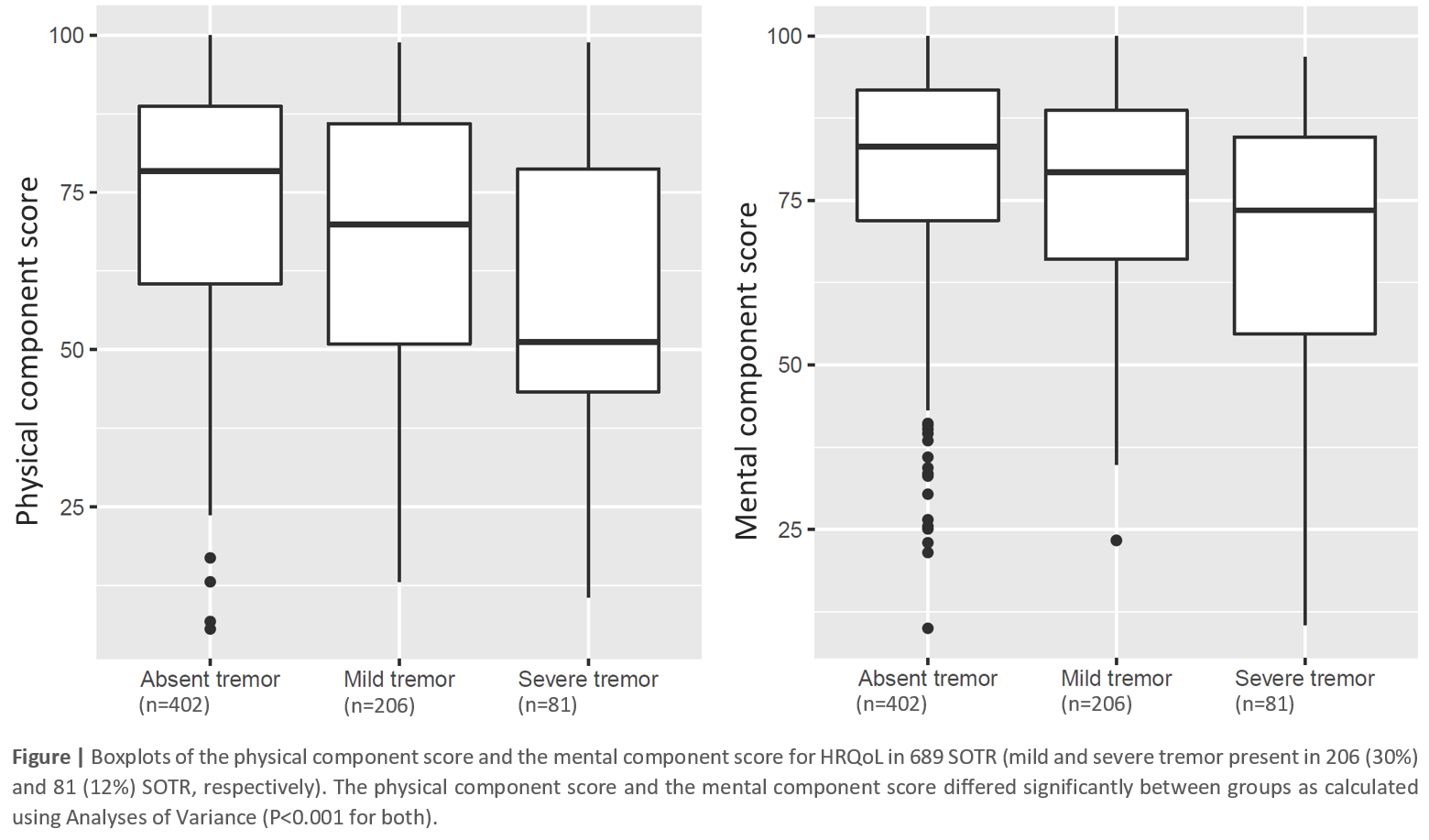Tremor, daily functioning, and quality of life in solid organ transplant recipients
Niels Riemersma1, Daan Kremer1, Tim J. Knobbe1, C. Tji Gan2, Svea Nolte1, António W. Gomes-Neto1, Hans Blokzijl3, Vincent E. de Meijer4, Kevin Damman5, Michele F. Eisenga1, Gea Drost6, Jan Willem J. Elting6, Daan J. Touw7,8, TransplantLines Investigators9, Stefan P. Berger1, Stephan J.L. Bakker1, A. Madelein M. van der Stouwe6,10.
1Department of Internal Medicine, Division of Nephrology, University of Groningen, University Medical Center Groningen, Groningen, Netherlands; 2Department of Pulmonary Diseases and Lung Transplantation, University of Groningen, University Medical Center Groningen, Groningen, Netherlands; 3Department of Gastroenterology and Hepatology, University of Groningen, University Medical Center Groningen, Groningen, Netherlands; 4Department of Hepato-Pancreato-Biliary Surgery and Liver Transplantation, University of Groningen, University Medical Center Groningen, Groningen, Netherlands; 5Department of Cardiology, University of Groningen, University Medical Center Groningen, Groningen, Netherlands; 6Department of Neurology and Clinical Neurophysiology, University of Groningen, University Medical Center Groningen, Groningen, Netherlands; 7Department of Clinical Pharmacy and Pharmacology, University of Groningen, University Medical Center Groningen, Groningen, Netherlands; 8Department of Pharmaceutical Analysis , University of Groningen, Groningen Research Institute of Pharmacy, Groningen, Netherlands; 9UMC Groningen Transplant Center, University Medical Center Groningen, Groningen, Netherlands; 10Expertice Center Movement Disorders Groningen, University of Groningen, University Medical Center Groningen, Groningen, Netherlands
Introduction: Even after successful transplantation, solid organ transplant recipients (SOTR) have reduced health-related quality of life (HRQoL) compared to the general population. A main cause is the occurrence of side effects of immunosuppressive therapy, generally including calcineurin inhibitors (CNI). One of these side-effects is tremor, which can be very debilitating in daily life. Currently, large studies assessing the burden of tremor among SOTR are lacking. We therefore aimed to investigate tremor prevalence and potential determinants of tremor. In addition, we aimed to assess the associations of tremor with HRQoL in SOTR.
Method: We used data from kidney, liver, lung, and heart transplant recipients at least one year after transplantation, enrolled in the TransplantLines Biobank and Cohort Study. Tremor was assessed using the patient-reported Fahn-Tolosa-Marin tremor rating scale C (TRS-C). Tremor severity was defined as absent, mild, or severe for each patient, depending on TRS-C score. Physical and mental HRQoL were assessed using the validated Short Form 36 questionnaire.
Results: We included 689 SOTR (39% female, mean [±SD] age 58 [±14] years), including kidney (n=395, 57.3%), liver (n=168, 24.4%), lung (n=95, 13.8%), and heart (n=29, 4.2%) transplant recipients at median 3 [range 1-9] years after transplantation. In total, 206 SOTR (30%) reported mild tremor and 81 (12%) reported severe tremor, with highest tremor prevalence among lung and heart transplant recipients. Multinomial logistic regression analyses showed that whole blood tacrolimus trough level was a determinant of tremor, independent of age, sex, and transplant type (OR per µg/L increase: 1.10, 95% CI: 1.00 to 1.21 for mild tremor and 1.14, 95% CI: 1.01 to 1.28 for severe tremor, P=0.045LRT ). Patients with either mild or severe tremor had significantly lower physical and mental HRQoL (P<0.001ANOVA for both, Figure). Furthermore, in linear regression analyses, severe tremor was strongly associated with lower physical and mental HRQoL (b -15.48, 95% CI: -21.07 to -9.89, p<0.001 and b -12.23, 95% CI: -17.26 to -7.19, p<0.001; resp.), independent of age, sex, type of transplantation, time after transplantation, polypharmacy, diabetes, anaemia, estimated glomerular filtration rate, use of tacrolimus, and use of cyclosporine.

Conclusions: Tremor is a prevalent clinical problem among SOTR, and its occurrence is strongly and independently associated with lower physical and mental HRQoL. Tacrolimus trough levels appeared a main determinant of tremor among SOTR. These findings highlight the need for novel treatment regimens, such as extended-release tacrolimus preparations, which may alleviate burden of tremor among SOTR and consequently contribute to improvements in HRQOL.
The TransplantLines Biobank and Cohort Study was financially supported by Astellas BV and Chiesi Pharmaceuticals BV. The funders had no role in the design of the study.

right-click to download
